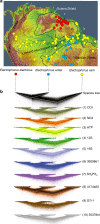Unexpected species diversity in electric eels with a description of the strongest living bioelectricity generator
- PMID: 31506444
- PMCID: PMC6736962
- DOI: 10.1038/s41467-019-11690-z
Unexpected species diversity in electric eels with a description of the strongest living bioelectricity generator
Abstract
Is there only one electric eel species? For two and a half centuries since its description by Linnaeus, Electrophorus electricus has captivated humankind by its capacity to generate strong electric discharges. Despite the importance of Electrophorus in multiple fields of science, the possibility of additional species-level diversity in the genus, which could also reveal a hidden variety of substances and bioelectrogenic functions, has hitherto not been explored. Here, based on overwhelming patterns of genetic, morphological, and ecological data, we reject the hypothesis of a single species broadly distributed throughout Greater Amazonia. Our analyses readily identify three major lineages that diverged during the Miocene and Pliocene-two of which warrant recognition as new species. For one of the new species, we recorded a discharge of 860 V, well above 650 V previously cited for Electrophorus, making it the strongest living bioelectricity generator.
Conflict of interest statement
The authors declare no competing interests.
Figures







References
-
- Linnaeus, C. Systema naturae per regna tria naturae, secundum classes, ordines, genera, species, cum characteribus, differentiis, synonymis, locis. Laurentii Salvii, Holmiae. 12th ed. v. 1 (pt 1): 1–532 (1766).
-
- Finger, S. & Piccolino, M. The Shocking History of Electric Fishes: From Ancient Epochs to the Birth of Modern Neurophysiology. (Oxford Univ. Press, Oxford, 2011).
-
- Encyclopedia Britannica, The Encyclopedia Britannica Publishing Co, 11th Edn. vol. 7 (1910).
Publication types
MeSH terms
LinkOut - more resources
Full Text Sources

